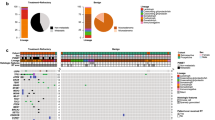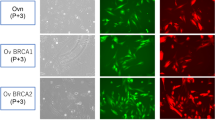Abstract
A new cell line, CA5171, derived from a chemotherapy-naive, high-grade undifferentiated ovarian carcinoma was established and characterized. The CA5171 cells presented with cobblestone morphology and a doubling time of 24 hours. Gene mutation analysis showed that the cells belonged to the type II ovarian cancer pathway with mutations of PIK3CA, PTEN, and TP53. Single-nucleotide polymorphism array analysis showed no homozygous gene deletion; however, several loci of gene copy number gains were noted in chromosome 1, 2, 5, 9, 10, 12, 15, 16, 20, and X. The in vitro and in vivo experiments showed that the cells were sensitive to paclitaxel and doxorubicin, but resistant to cisplatin. The cells also presented epithelial-mesenchymal transition properties that may have been related to their invasion and migration potential. The CA5171 cells show the potential as a new cell line for studies on epithelial ovarian carcinoma.
Similar content being viewed by others
References
Jemal A, Siegel R, Ward E, Hao Y, Xu J, Thun MJ. Cancer statistics, 2009. CA Cancer J Clin. 2009;59(4):225–249.
Jemal A, Siegel R, Xu J, Ward E. Cancer statistics, 2010. CA Cancer J Clin. 2010;60(5):277–300.
Agarwal R, Kaye SB. Ovarian cancer: strategies for overcoming resistance to chemotherapy. Nat Rev Cancer. 2003;3(7):502–516.
Kurman RJ, Shih Ie M. The origin and pathogenesis of epithelial ovarian cancer: a proposed unifying theory. Am J Surg Pathol. 2010;34(3):433–443.
Kuo KT, Mao TL, Jones S, et al. Frequent activating mutations of PIK3CA in ovarian clear cell carcinoma. Am J Pathol. 2009;174(5):1597–1601.
Lu TP, Lai LC, Tsai MH, et al. Integrated analyses of copy number variations and gene expression in lung adenocarcinoma. PLoS One. 2011;6(9):e24829.
Aoki D, Suzuki N, Susumu N, et al. Establishment and characterization of the RMG-V cell line from human ovarian clear cell adenocarcinoma. Hum Cell. 2005;18(3):143–146.
Nishikawa Y, Yoshida Y, Kawahara K, Kurokawa T, Tajima K, Kotsuji F. Establishment of a novel human ovarian cancer cell line with high anchorage-independent growth ability. Int J Oncol. 2003;23(6):1679–1686.
Scoles DR, Pavelka J, Cass I, et al. Characterization of CSOC 882, a novel immortalized ovarian cancer cell line expressing EGFR, HER2, and activated AKT. Gynecol Oncol. 2007;104(1):120–128.
Alama A, Barbieri F, Favre A, et al. Establishment and characterization of three new cell lines derived from the ascites of human ovarian carcinomas. Gynecol Oncol. 1996;62(1):82–88.
Hirte HW, Kaiser JS, Bacchetti S. Establishment and characterization of four human epithelial ovarian carcinoma cell lines. Cancer. 1994;74(3):900–906.
Provencher DM, Finstad CL, Saigo PE, et al. Comparison of antigen expression on fresh and cultured ascites cells and on solid tumors of patients with epithelial ovarian cancer. Gynecol Oncol. 1993;50(1):78–83.
Mobus V, Gerharz CD, Press U, et al. Morphological, immunohistochemical and biochemical characterization of 6 newly established human ovarian carcinoma cell lines. Int J Cancer. 1992;52(1):76–84.
Wong WS, Wong YF, Ng YT, et al. Establishment and characterization of a new human cell line derived from ovarian clear cell carcinoma. Gynecol Oncol. 1990;38(1):37–45.
Langdon SP, Lawrie SS, Hay FG, et al Characterization and properties of nine human ovarian adenocarcinoma cell lines. Cancer Res. 1988;48(21):6166–6172.
Hamilton TC, Young RC, McKoy WM, et al. Characterization of a human ovarian carcinoma cell line (NIH: OVCAR-3) with androgen and estrogen receptors. Cancer Res. 1983;43(11):5379–5389.
Kurman RJ, Shih Ie M. Molecular pathogenesis and extraovarian origin of epithelial ovarian cancer—shifting the paradigm. Hum Pathol. 2011;42(7):918–931.
Banerjee S, Kaye SB. New strategies in the treatment of ovarian cancer: current clinical perspectives and future potential. Clin Cancer Res. 2013;19(5):961–968.
Cancer Genome Atlas Research Network. Integrated genomic analyses of ovarian carcinoma. Nature. 2011;474(7353):609–615.
Almeida A, Zhu XX, Vogt N, et al. GAC1, a new member of the leucine-rich repeat superfamily on chromosome band 1q32.1, is amplified and overexpressed in malignant gliomas. Oncogene. 1998;16(23):2997–3002.
Giroux V, Iovanna JL, Garcia S, Dagorn JC. Combined inhibition of PAK7, MAP3K7 and CK2alpha kinases inhibits the growth of MiaPaCa2 pancreatic cancer cell xenografts. Cancer Gene Ther. 2009;16(9):731–740.
Gong W, An Z, Wang Y, et al. P21-activated kinase 5 is overexpressed during colorectal cancer progression and regulates colorectal carcinoma cell adhesion and migration. Int J Cancer. 2009;125(3):548–555.
Gu J, Li K, Li M, et al. A role for p21-activated kinase 7 in the development of gastric cancer. FEBS J. 2013;280(1):46–55.
Wild JR, Staton CA, Chapple K, Corfe BM. Neuropilins: expression and roles in the epithelium. Int J Ex Pathol. 2012;93(2): 81–103.
Lin DC, Xu L, Ding LW, et al. Genomic and functional characterizations of phosphodiesterase subtype 4D in human cancers. Proc Natl Acad Sci USA. 2013;110(15):6109–6114.
Berois N, Gattolliat CH, Barrios E, et al. GALNT9 gene expression is a prognostic marker in neuroblastoma patients. Clin Chem. 2013;59(1):225–233.
Berx G, van Roy F. Involvement of members of the cadherin superfamily in cancer. Cold Spring Harb Perspect Biol. 2009; 1(6):a003129.
Bordow SB, Norris MD, Haber PS, Marshall GM, Haber M. Prognostic significance of MYCN oncogene expression in childhood neuroblastoma. J Clin Oncol. 1998;16(10):3286–3294.
Jacobs JF, van Bokhoven H, van Leeuwen FN, et al. Regulation of MYCN expression in human neuroblastoma cells. BMC Cancer. 2009;9:239.
Thiery JP, Acloque H, Huang RY, Nieto MA. Epithelial–mesenchymal transitions in development and disease. Cell. 2009;139(5):871–890.
Peinado H, Olmeda D, Cano A. Snail, Zeb and bHLH factors in tumour progression: an alliance against the epithelial phenotype? Nat Rev Cancer. 2007;7(6):415–428.
Zhou XM, Zhang H, Han X. Role of epithelial to mesenchymal transition proteins in gynecological cancers: pathological and therapeutic perspectives [published online August 29, 2014]. Tumour Biol. 2014.
Yang J, Weinberg RA. Epithelial–mesenchymal transition: at the crossroads of development and tumor metastasis. Dev Cell. 2008; 14(6):818–829.
Hurt EM, Saykally JN, Anose BM, Kalli KR, Sanders MM. Expression of the ZEB1 (deltaEF1) transcription factor in human: additional insights. Mol Cell Biochem. 2008;318(1–2):89–99.
Schmalhofer O, Brabletz S, Brabletz T. E-cadherin, beta-catenin, and ZEB1 in malignant progression of cancer. Cancer Metastasis Rev. 2009;28(1–2):151–166.
Davidowitz RA, Selfors LM, Iwanicki MP, et al. Mesenchymal gene program-expressing ovarian cancer spheroids exhibit enhanced mesothelial clearance. J Clin Invest. 2014;124(6):2611–2625.
Author information
Authors and Affiliations
Corresponding author
Rights and permissions
About this article
Cite this article
Chiang, YC., Cheng, WF., Chang, MC. et al. Establishment of a New Ovarian Cancer Cell Line CA5171. Reprod. Sci. 22, 725–734 (2015). https://doi.org/10.1177/1933719114557893
Published:
Issue Date:
DOI: https://doi.org/10.1177/1933719114557893




